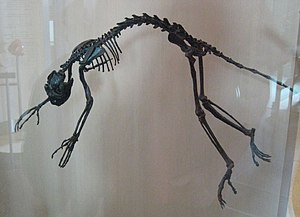Adapiformes
| Adapiformes | ||||||||||||
|---|---|---|---|---|---|---|---|---|---|---|---|---|

Skeleton of Notharctus tenebrosus in the American Museum of Natural History |
||||||||||||
| Temporal occurrence | ||||||||||||
| Eocene to Miocene | ||||||||||||
| 55 to 13 million years | ||||||||||||
| Locations | ||||||||||||
| Systematics | ||||||||||||
|
||||||||||||
| Scientific name | ||||||||||||
| Adapiformes | ||||||||||||
| Hoffstetter , 1977 | ||||||||||||
The Adapiformes or Adapoidea are an extinct group of primates that was traditionally assigned to the wet-nosed monkeys (Strepsirrhini). They are among the oldest primates found to date and originated around 50 million years ago.
description
In terms of physique and size, these animals were similar to today's wet-nosed monkeys, but they still have a number of primeval features: The tooth formula of the earlier representatives was 2-1-4-3 (two incisors , one canine , four premolars and three molars per half of the jaw ), which, with the exception of a missing incisor, corresponded to the original mammalian tooth formula 3-1-4-3. However, the beginning development of a large brain and palpable limbs (both typical primate features) can already be recognized. Based on the teeth, it is assumed that these animals mainly fed on leaves. Long hind legs and a strong tail indicate that they have moved in the trees by climbing and jumping.
Find situation
The majority of the finds come from the period from the early Eocene to the early Oligocene (around 55 to 35 million years ago) from North America and Eurasia . In Europe and North America, they are likely to have died out in the early Oligocene, but in Asia there is a family, the Sivaladapidae , that lived in the Middle Miocene (around 13 million years ago). Between the two periods, however, there is a large gap in the fossil record, so that the more precise relationships within this suborder and between the Adapiformes and today's wet-nosed monkeys remain unexplained until further finds appear.
The finds made so far are divided into three families of the Adapoidea:
- The Notharctidae lived in North America and Europe during the Eocene. The best-known genera include Notharctus and Europolemur and the genus Darwinius, discovered in 2009 .
- The Adapidae are a little younger than the Notharctidae. Finds are mostly known from Europe from the middle Eocene to the early Oligocene. The best-known genus and namesake is Adapis .
- The Sivaladapidae are documented from China and India . In addition to finds from the Eocene and early Oligocene, there are species from the Middle Miocene, including Sivaladapis .
Systematics
Since the Adapiformes are only known from fossil records, it is not clear whether they represent a monophyletic or a paraphyletic group.
Under the first assumption, that it is a clade , they are usually assigned to the wet-nosed monkeys (Strepsirrhini). This would make them relatives of the lemurs (Lemuriformes); but not the dry- nosed monkey (Haplorhini), to which the real monkeys belong.
Franzen et al. (2009) place the genus Darwinius (handed down through the fossil 'Ida' from the Messel pit ) in the group of the Adapoidea and see the lack of the tooth comb and cleaning claw as a sign that these primates belong to the dry-nosed monkeys. In October 2009 a new genus of Adapiformes was described with Afradapis . Eric Seiffert et al., The first to describe it, placed the Adapiformes back into the wet-nosed monkeys after a detailed phylogenetic analysis, as sister taxons of today's forms.
| Primates (Primates) |
|
||||||||||||||||||||||||||||||
|
|
literature
- Thomas Geissmann : Comparative Primatology. Springer-Verlag, Berlin et al. 2002, ISBN 3-540-43645-6 .
Web links
Individual evidence
- ↑ DL Gebo: Adapiformes: Phylogeny and adaptation . In: WC Hartwig (Ed.): The Primate Fossil Record . Cambridge University Press, 2008, ISBN 978-0-521-08141-2 , pp. 21-43.
- ↑ Callum Ross, Richard F. Kay, Anthropoid origins: new visions , Springer, 2004, ISBN 978-0-306-48120-8 , p. 100
- ↑ Jens L. Franzen, Philip D. Gingerich, Jörg Habersetzer, Jørn H. Hurum, Wighart von Koenigswald, B. Holly Smith: Complete Primate Skeleton from the Middle Eocene of Messel in Germany: Morphology and Paleobiology . In: PLoS ONE . Vol. 4, No. 5 , May 19, 2009, p. e5723 , doi : 10.1371 / journal.pone.0005723 (English).
- ↑ Erik R. Seiffert, Jonathan MG Perry, Elwyn L. Simons and Doug M. Boyer: Convergent evolution of anthropoid-like adaptations in Eocene adapiform primates. Nature 461, 2009, pp. 1118-1121, doi: 10.1038 / nature08429 ; see also report at the-scientist.com
